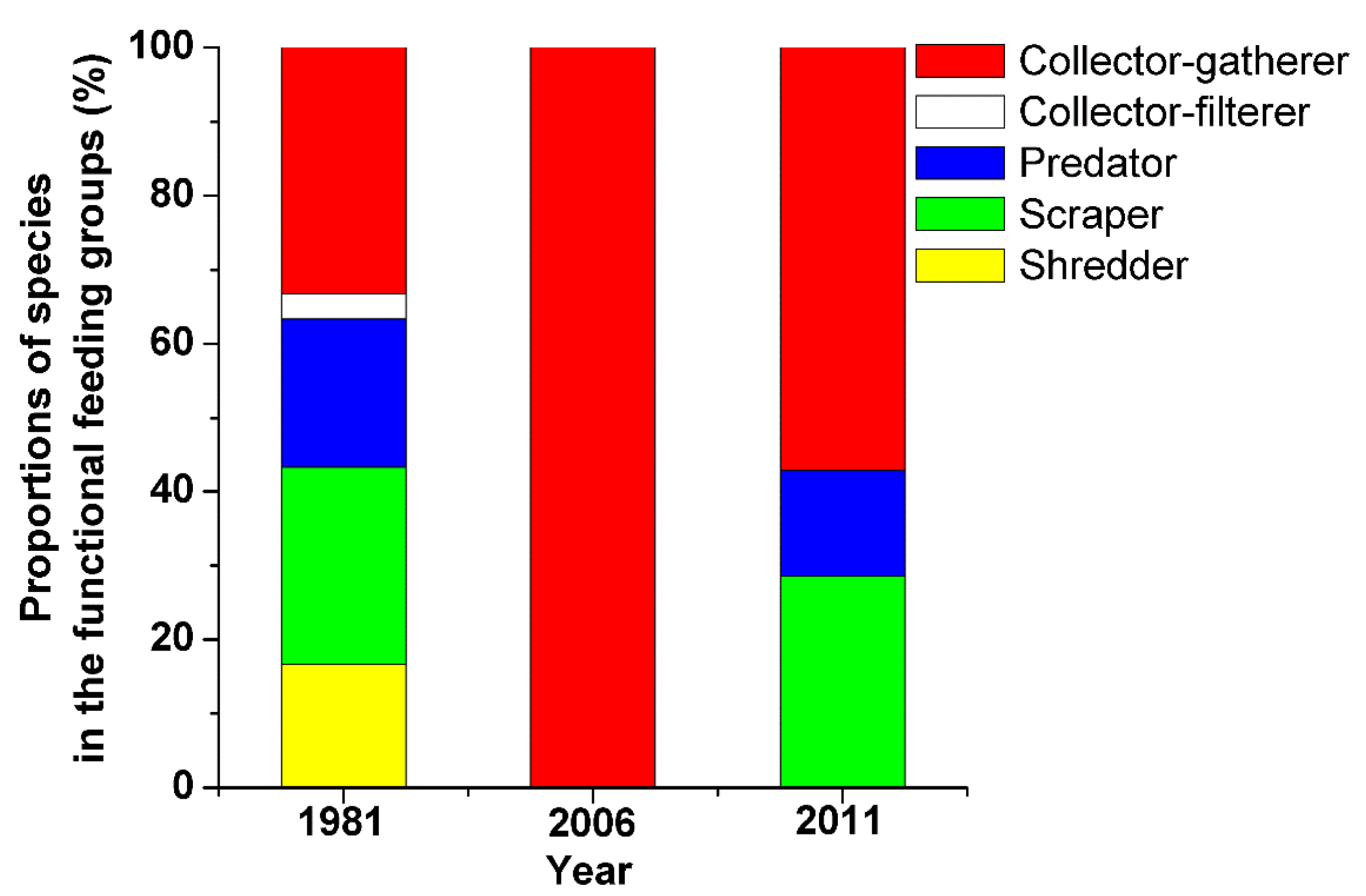Long-Term Changes in the Water Quality and Macroinvertebrate Communities of a Subtropical River in South China
Abstract
:1. Introduction
2. Materials and Methods
2.1. Study Area
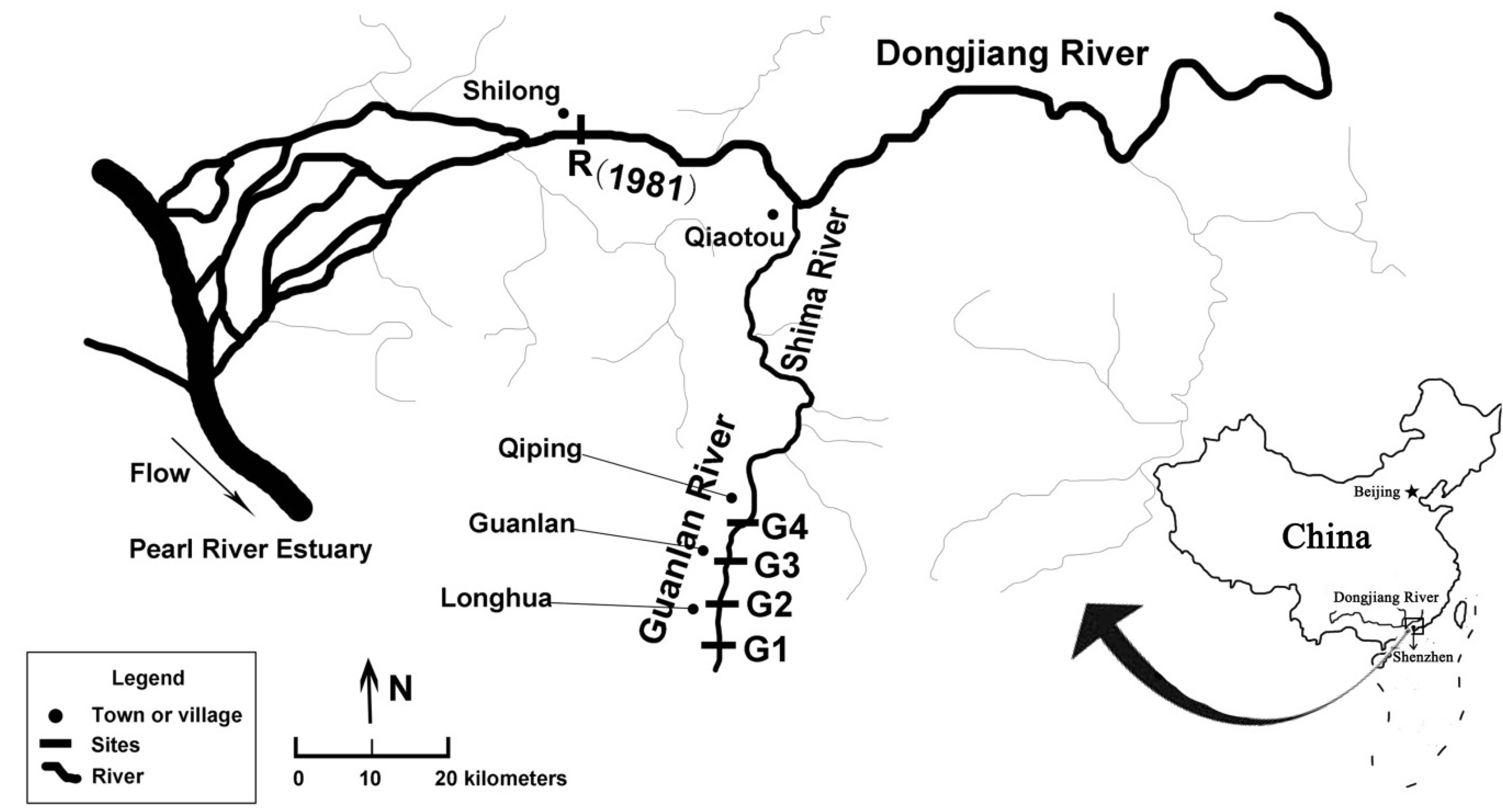
2.2. Data Collection Methods
| Sites | Longitude and Latitude | Comments |
|---|---|---|
| G1 site | 22°38'22" N, 114°2'38" E | The upstream origin of the Guanlan River |
| G2 site | 22°39'52" N, 114°2'19" E | The merging point of the Longhua River branch |
| G3 site | 22°41'10" N, 114°2'25" E | The midstream site at Qinghu reach |
| G4 site | 22°44'7" N, 114°3'32" E | The downstream site at Guihua Village |
2.3. Metrics Selection and Calculation Methods
2.4. Data Analysis
3. Results
3.1. Analyses of Water Pollution
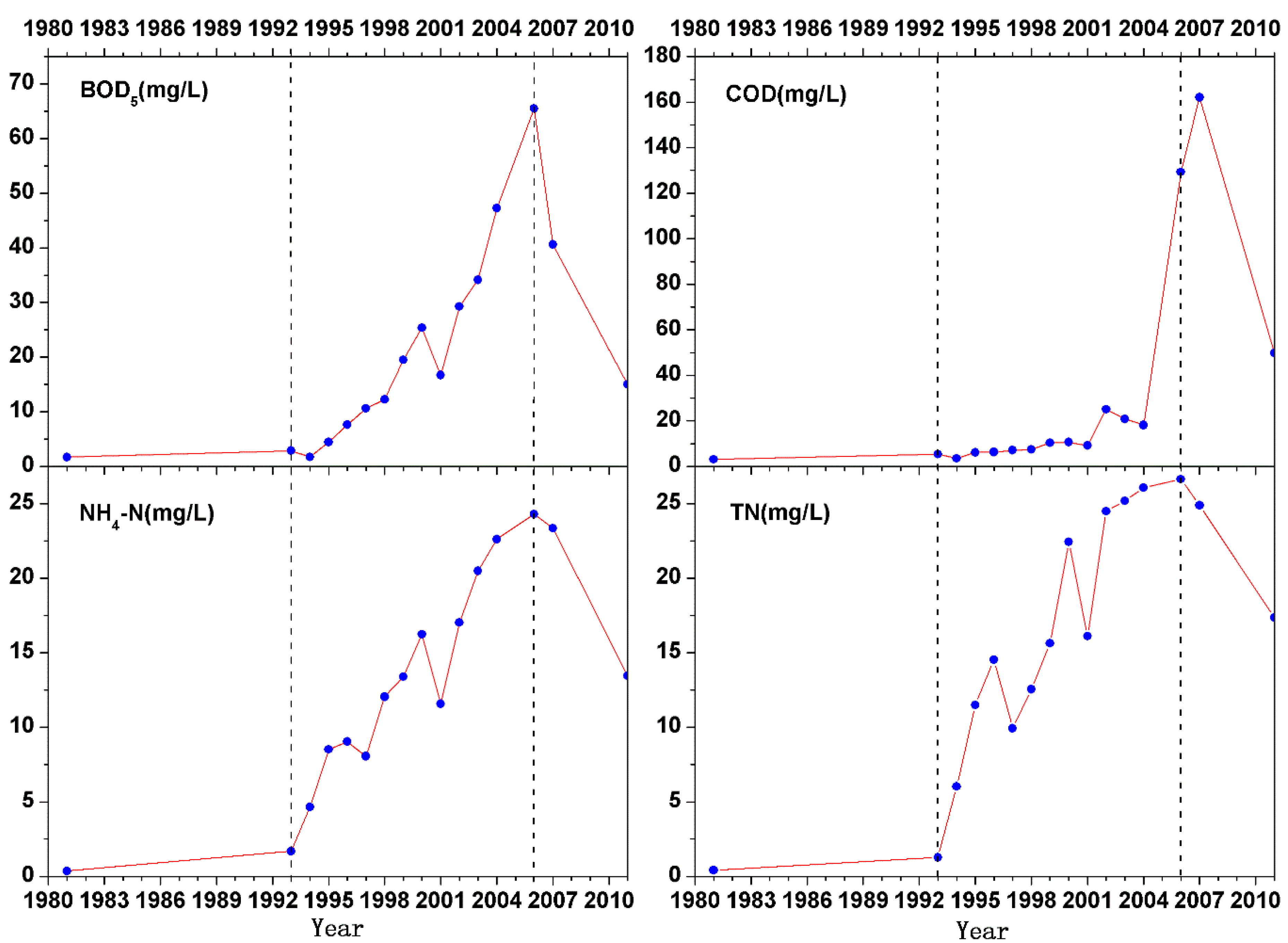
| Period of Change | BOD5 (mg/L) | COD (mg/L) | NH4-N (mg/L) | TN (mg/L) | |
|---|---|---|---|---|---|
| Guanlan river | First period (1981–1993) | 1.69–2.87 (I-I) | 3.08–5.37 (II-III) | 0.36–1.68 (II-V) | 0.41–1.72 (II-V) |
| Second period (1993–2006) | 2.87–65.53 (I-V+) | 5.37–129.30 (III-V+) | 1.68–24.30 (V-V+) | 1.72–26.64 (V-V+) | |
| Third period (2006–2011) | 65.53–15.40 (V+-V+) | 129.30–49.76 (V+-V+) | 24.30–13.44 (V+-V+) | 26.64–17.35 (V+-V+) | |
| National environmental quality standards for surface water | I | ≤3 | ≤2 | ≤0.15 | ≤0.2 |
| II | ≤3 | ≤4 | ≤0.5 | ≤0.5 | |
| III | ≤4 | ≤6 | ≤1.0 | ≤1.0 | |
| IV | ≤6 | ≤10 | ≤1.5 | ≤1.5 | |
| V | ≤10 | ≤15 | ≤2.0 | ≤2.0 | |
3.2. Structural and Functional Changes in Macroinvertebrate Communities
3.2.1. Structural Changes in Macroinvertebrate Communities
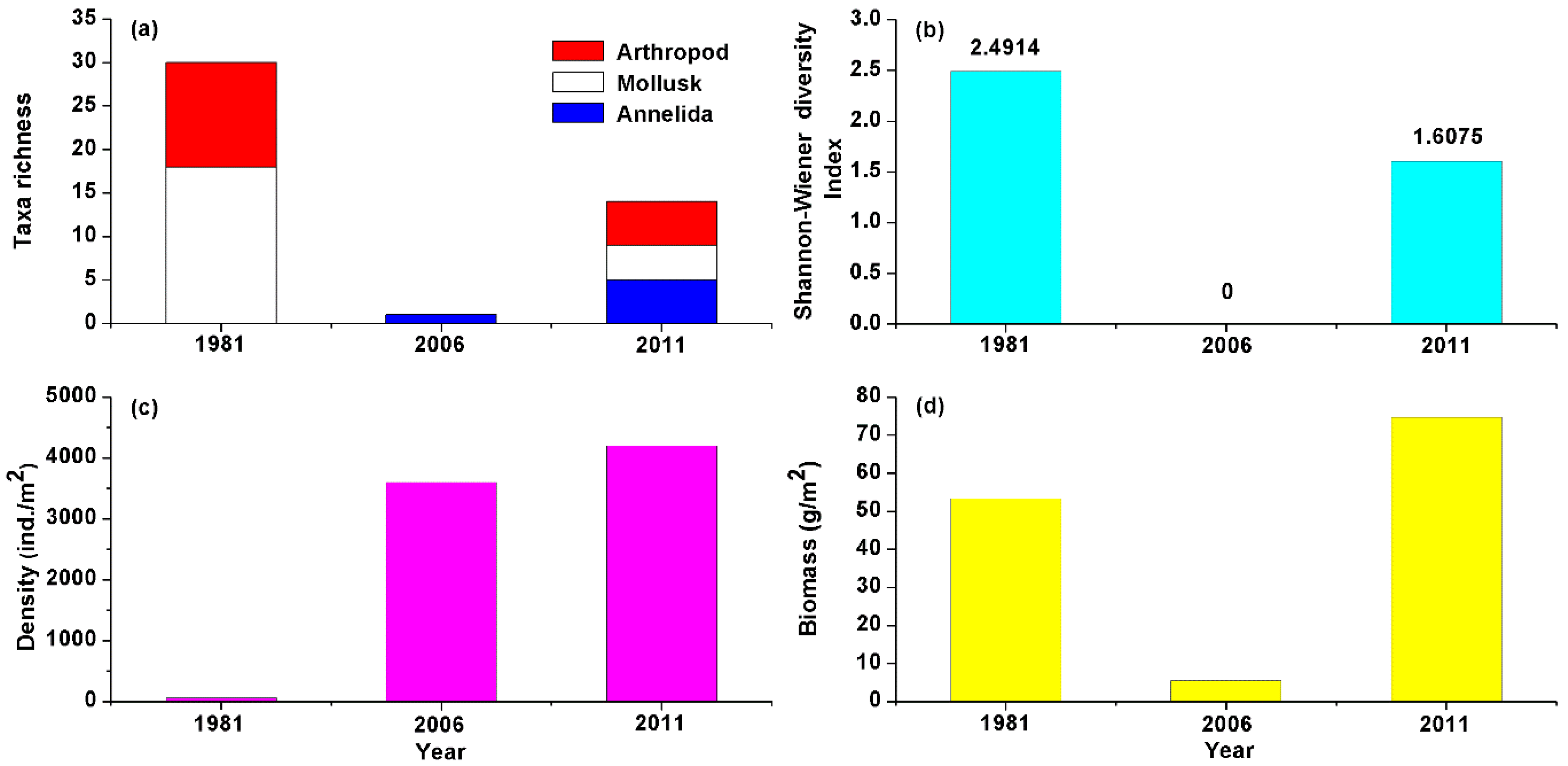
| 1981 | 2006 | 2011 |
|---|---|---|
| Cipangopaludina chinensis | Tubifex sp. | Physa foncinalis |
| Bellamya aeruginosa | - | Bithynia fuchsiana |
| Bellamya limnophila | - | Semisulcospira libertina |
| Bellamya purificata | - | Hippeutis umbilicalis |
| Angulyagra polyzonata | - | Procladius choreus |
| Melanoides tuberculata | - | Pelopia sp. |
| Radix auricularia | - | Chironomus attenuatus |
| Radix swinhoei | - | Cricotopus trifasciatus |
| Limnoperna lacustris | - | Psychoda sp. |
| Unio douglasiae | - | Tubifex sinicus |
| Lanceolaria grayana | - | Limnodrilus hoffmeisteri |
| Lamprotula leai | - | Monopylephorus limosus |
| Anodonta woodiana woodiana | - | Branchiura sowerbyi |
| Anodonta woodiana pacifica | - | Nais variabilis |
| Anodonta woodiana elliptica | - | - |
| Anodonta lucida | - | - |
| Corbicula fluminea | - | - |
| Corbicula nitens | - | - |
| Somanniathelphusa sinensis | - | - |
| Sesarma dehaani | - | - |
| Macrobrachium nipponensis | - | - |
| Macrobrachium sp. | - | - |
| Macrobrachium hainanense | - | - |
| Odonata sp. | - | - |
| Lethocerus indicus | - | - |
| Sphaerodema rustica | - | - |
| Enithares sinica | - | - |
| Notoerta montandoni | - | - |
| Cybister sp. | - | - |
| Chironomidae sp. | - | - |
3.2.2. Structural Changes in the Compositions of the Functional Feeding Groups
3.3. Responses of River Ecosystems to Water Pollution
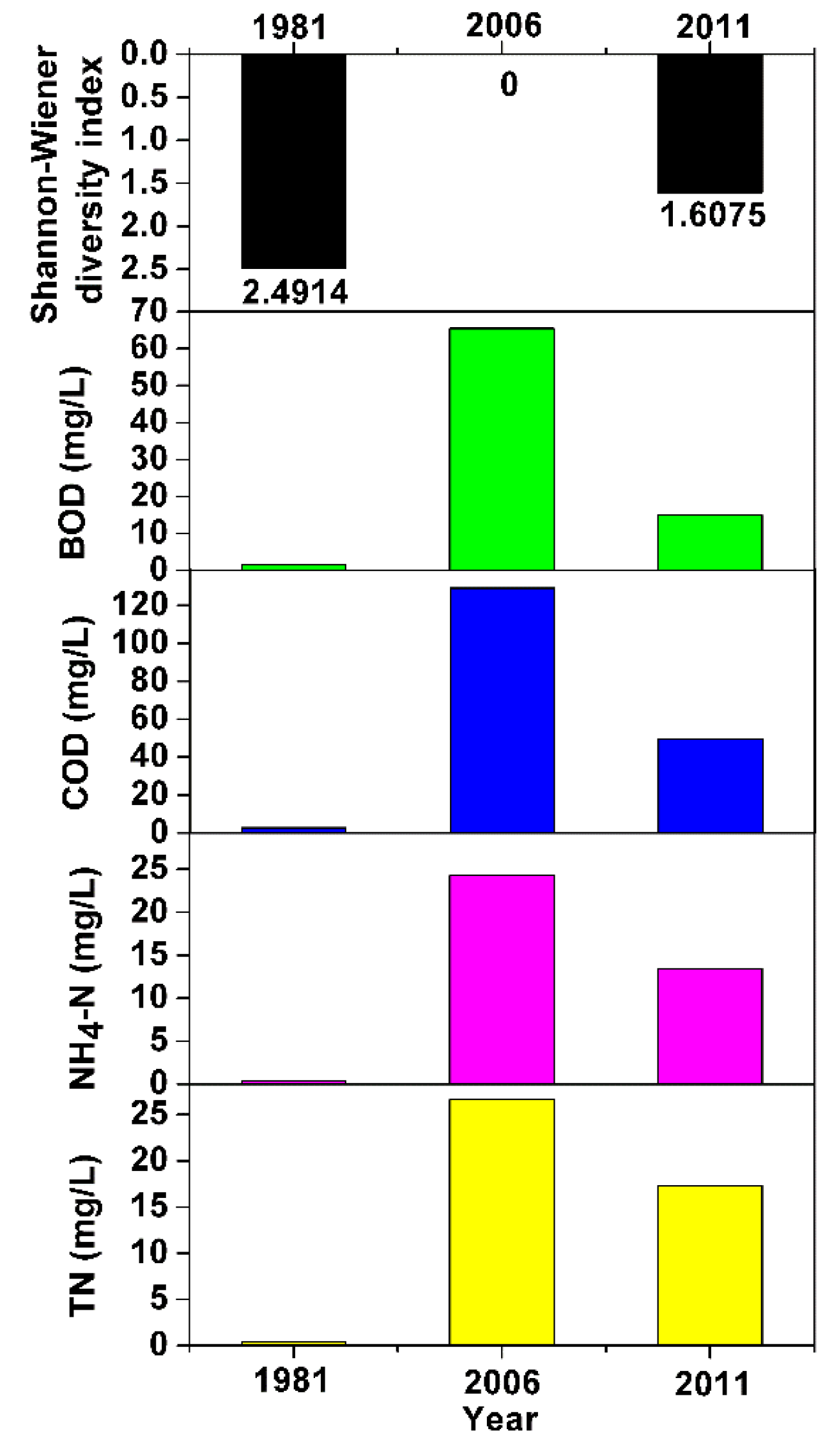
| Indices | BOD | COD | NH4-N | TN |
|---|---|---|---|---|
| Taxa richness | 0.552 ** | 0.559 ** | 0.606 ** | 0.542 ** |
| Shannon-Wiener diversity index | −0.409 * | −0.477 * | −0.468 * | −0.454 * |
| Density | 0.102 | 0.058 | 0.338 | 0.265 |
| Biomass | 0.044 | 0.132 | 0.237 | 0.263 |
3.4. Impacts of the Ecological Restoration
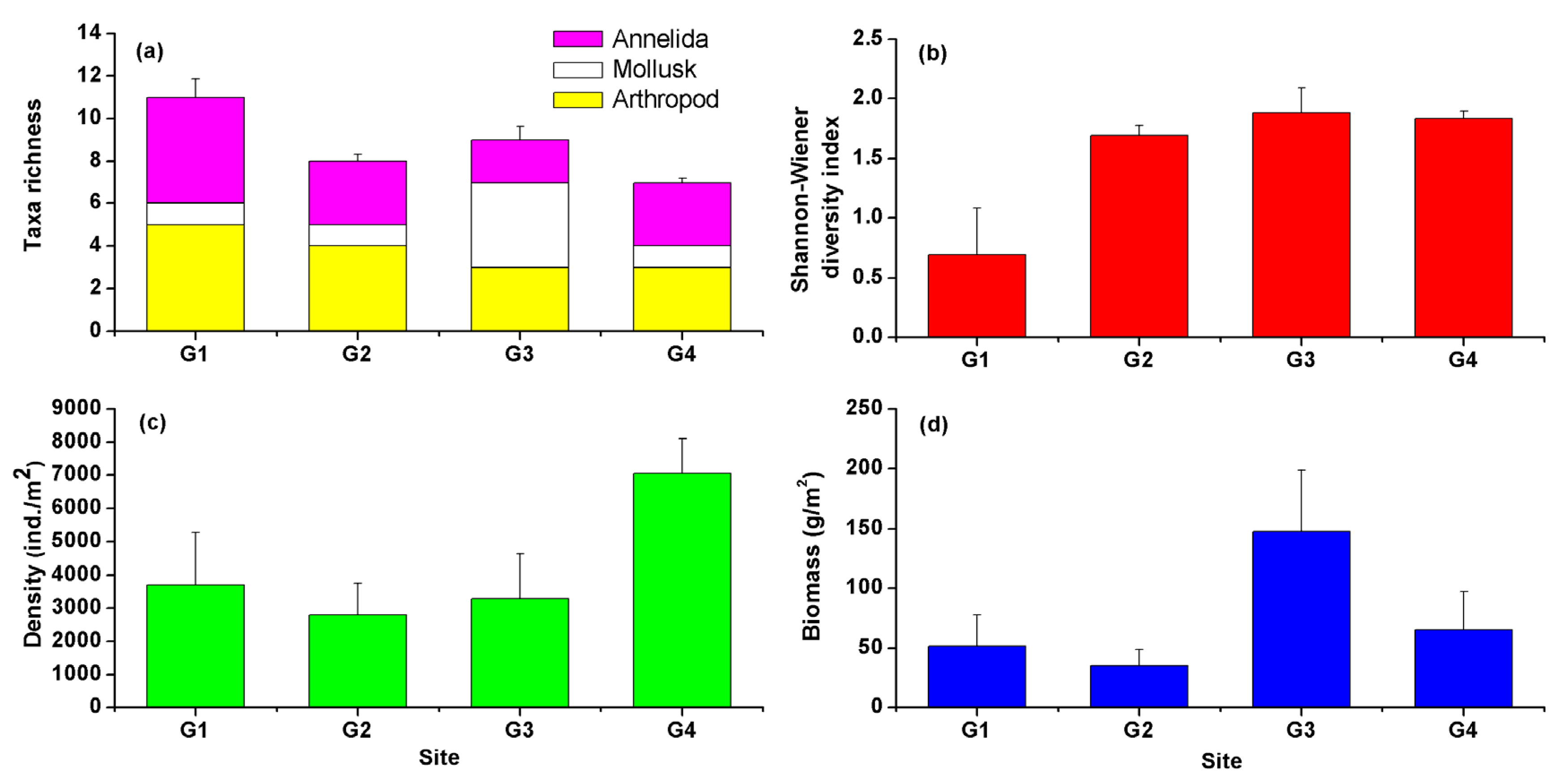
4. Discussion
5. Conclusions
Acknowledgments
Author Contributions
Conflicts of Interest
References
- Jackson, R.B.; Carpenter, S.R.; Dahm, C.N.; McKnight, D.M.; Naiman, R.J.; Postel, S.L.; Running, S.W. Water in a changing world. Ecol. Appl. 2001, 11, 1027–1045. [Google Scholar]
- Al-Shami, S.A.; Md Rawi, C.S.; Ahmad, A.H.; Abdul Hamid, S.; Mohd Nor, S.A. Influence of agricultural, industrial, and anthropogenic stresses on the distribution and diversity of macroinvertebrates in Juru River Basin, Penang, Malaysia. Ecotox. Environ. Safe 2011, 74, 1195–1202. [Google Scholar]
- Friberg, N.; Bonada, N.; Bradley, D.C.; Dunbar, M.J.; Edwards, F.K.; Grey, J.; Hayes, R.B.; Hildrew, A.G.; Lamouroux, N.; Trimmer, M. Biomonitoring of human impacts in freshwater ecosystems: The good, the bad and the ugly. Adv. Ecol. Res. 2011, 44, 1–68. [Google Scholar]
- Zhang, Y.; Dudgeon, D.; Cheng, D.; Thoe, W.; Fok, L.; Wang, Z.; Lee, J.H.W. Impacts of land use and water quality on macroinvertebrate communities in the Pearl River drainage basin, China. Hydrobiologia 2010, 652, 71–88. [Google Scholar]
- Niu, C.J.; Lou, A.R.; Sun, R.Y.; Li, Q.F. Basic Ecology, 2nd ed.; Higher Education Press: Beijing, China, 2007. (In Chinese) [Google Scholar]
- Duan, X.H.; Wang, Z.Y.; Xu, M.Z. Benthic Macroinvertebrate and Application in the Assessment of Stream Ecology; Tsinghua University Press: Beijing, China, 2010. (In Chinese) [Google Scholar]
- Norris, R.H.; Thoms, M.C. What is river health? Freshwater Biol. 1999, 41, 197–209. [Google Scholar]
- Bao, Y.X.; Ge, B.M.; Zheng, X.; Cheng, H.Y. Spatial distribution and seasonal variation of the macrobenthic community on tidal flats of Tianhe, Wenzhou Bay. Acta Zool. Sin. 2006, 52, 45–52. (In Chinese) [Google Scholar]
- De Pauw, N.; Gabriels, W.; Goethals, P.L. River monitoring and assessment methods based on macroinvertebrates. In Biological Monitoring of Rivers; Ziglio, G., Flaim, G., Siligardi, M., Eds.; John Wiley & Sons: Chichester, UK, 2006; pp. 113–134. [Google Scholar]
- Murphy, J.F.; Winterbottom, J.H.; Orton, S.; Simpson, G.L.; Shilland, E.M.; Hildrew, A.G. Evidence of recovery from acidification in the macroinvertebrate assemblages of UK fresh waters: A 20-year time series. Ecol. Indic. 2014, 37, 330–340. [Google Scholar]
- Nguyen, H.H.; Everaert, G.; Gabriels, W.; Hoang, T.H.; Goethals, P.L.M. A multimetric macroinvertebrate index for assessing the water quality of the Cau river basin in Vietnam. Limnologica 2014, 45, 16–23. [Google Scholar]
- Dos Santos, D.; Molineri, C.; Reynaga, M.; Basualdo, C. Which index is the best to assess stream health? Ecol. Indic. 2011, 11, 582–589. [Google Scholar]
- Karr, J.R. Defining and measuring river health. Freshwater Biol. 1999, 41, 221–234. [Google Scholar]
- Shao, M.L.; Xie, Z.C.; Ye, L.; Cai, Q.H. Monthly change of community structure of zoobenthos in Xiangxi Bay after impoundment of three gorges reservoir. Acta Hydrob. Sin. 2006, 30, 64–69. (In Chinese) [Google Scholar]
- Smith, M.; Kay, W.; Edward, D.; Papas, P.; Richardson, K.S.J.; Simpson, J.; Pinder, A.; Cale, D.; Horwitz, P.; Davis, J. AusRivAS: Using macroinvertebrates to assess ecological condition of rivers in Western Australia. Freshwater Biol. 1999, 41, 269–282. [Google Scholar]
- Wang, B.X.; Yang, L.F. A study on tolerance values of benthic macroinvertebrate taxa in eastern China. Acta Ecol. Sin. 2004, 24, 2768–2775. (In Chinese) [Google Scholar]
- Lai, Z.X. Survey on benthic macroinvertebrate in Dongjiang River water system in Guangdong province. Freshw. Fish 1988, 21, 28–34. (In Chinese) [Google Scholar]
- Fu, G.P.; Zhu, W.B.; Li, C.F.; Huang, Y.L. Research on the ecological restoration project of the qinghu channel, the Guanlan River in Shenzhen. China Rural Water Hydropower 2008, 34, 57–61. (In Chinese) [Google Scholar]
- Wu, H.R.; Li, L.L. The changing trend in water quality pollution in Baoan Disrict section of Guanlan River in Shenzhen City and the strategy for prevention and treament. Guangzhou Environ. 2000, 15, 42–44. (In Chinese) [Google Scholar]
- Dongguan City Sanitation and Antiepidemic Station. Survey on the reform of rural drinking water in Dongguan City. Guangdong Heal. Epidemic Prev. Inform. 1979, 5, 31–37. (In Chinese) [Google Scholar]
- Li, W.B. Pollution scenarios in Pearl River water system. Pearl River 1982, 3, 29–32. (In Chinese) [Google Scholar]
- Chen, Q.D. Water resources of Shenzhen. Trop. Geogr. 1986, 6, 51–62. (In Chinese) [Google Scholar]
- Yue, J.; Wang, Y.L.; Li, Z.G.; Zhang, Y.; Bu, X.G. Spatial-temporal trends of water quality and its influence by land use: A case study of the main rivers in Shenzhen. Adv. Water Sci. 2006, 17, 359–364. (In Chinese) [Google Scholar]
- Chinese Research Academy of Environmental Sciences. Environmental Quality Standards for Surface Water; China Environmental Science Press: Beijing, China, 2003. (In Chinese) [Google Scholar]
- Huang, Y.L.; Wang, Y.L. River water quality degredation in Shenzhen City and its influencing mechanisms. China Rural Water Hydropower 2007, 33, 10–13. (In Chinese) [Google Scholar]
- Simberloff, D.; Dayan, T. The guild concept and the structure of ecological communities. Annu. Rev. Ecol. Syst. (In Chinese) 1991, 22, 115–143. [Google Scholar]
- Vannote, R.L.; Minshall, G.W.; Cummins, K.W.; Sedell, J.R.; Cushing, C.E. The river continuum concept. Can. J. Fish. Aquat. Sci. 1980, 37, 130–137. [Google Scholar]
- Orendt, C.; Wolfram, G.; Adámek, Z.; Jurajda, P.; Schmitt-Jansen, M. The response of macroinvertebrate community taxa and functional groups to pollution along a heavily impacted river in Central Europe (Bílina River, Czech Republic). Biologia 2012, 67, 180–199. [Google Scholar]
- Friberg, N.; Dybkjær, J.B.; Olafsson, J.S.; Gislason, G.M.; Larsen, S.E.; Lauridsen, T.L. Relationships between structure and function in streams contrasting in temperature. Freshwater Biol. 2009, 54, 2051–2068. [Google Scholar]
- Merritt, R.; Cummins, K. Trophic relations of macroinvertebrates. In Methods in Stream Ecology; Hauer, F.R., Lamberti, G.A., Eds.; Academic Press: San Diego, CA, USA, 2007; pp. 585–610. [Google Scholar]
- Shannon, C.E.; Weaver, W.J. The Mathematical Theory of Communication; University of Illinois Press: Urbana, IL, USA, 1949. [Google Scholar]
- Che, Y.; Yang, K.; Wu, E.; Shang, Z.; Xiang, W. Assessing the health of an urban stream: A case study of Suzhou Creek in Shanghai, China. Environ. Monit. Assess. 2012, 184, 7425–7438. [Google Scholar]
- Liu, H.Z.; Lu, X.Y. Comparison of water pollution control between rivers in China and abroad. World Environ. 2001, 19, 27–30. (In Chinese) [Google Scholar]
- Wilken, R.D. The Recovered Rhine and Its History. In The Rhine; Knepper, T., Ed.; Springer: Berlin, Germany, 2006; pp. 47–87. [Google Scholar]
- Thorne, R.; Williams, P. The response of benthic macroinvertebrates to pollution in developing countries: A multimetric system of bioassessment. Freshwater Biol. 1997, 37, 671–686. [Google Scholar]
- Beyene, A.; Legesse, W.; Triest, L.; Kloos, H. Urban impact on ecological integrity of nearby rivers in developing countries: The Borkena River in highland Ethiopia. Environ. Monit. Assess. 2009, 153, 461–476. [Google Scholar]
- Dudgeon, D. The impacts of human disturbance on stream benthic invertebrates and their drift in North Sulawesi, Indonesia. Freshwater Biol. 2006, 51, 1710–1729. [Google Scholar]
- Allan, J.D.; Castillo, M.M. Stream Ecology: Structure and Function of Running Waters; Springer: Berlin, Germany, 2007. [Google Scholar]
- Álvarez-Cabria, M.; Barquín, J.; Juanes, J.A. Microdistribution patterns of macroinvertebrate communities upstream and downstream of organic effluents. Water Res. 2011, 45, 1501–1511. [Google Scholar]
- Arimoro, F.O.; Ikomi, R.B.; Iwegbue, C. Water quality changes in relation to Diptera community patterns and diversity measured at an organic effluent impacted stream in the Niger Delta, Nigeria. Ecol. Indic. 2007, 7, 541–552. [Google Scholar]
- Dudgeon, D. Responses of benthic macroinvertebrate communities to altitude and geology in tributaries of the Sepik River (Papua New Guinea): The influence of taxonomic resolution on the detection of environmental gradients. Freshwater Biol. 2012, 57, 1794–1812. [Google Scholar]
- McCabe, D.J.; Hayes-Pontius, E.M.; Canepa, A.; Berry, K.S.; Levine, B.C. Measuring standardized effect size improves interpretation of biomonitoring studies and facilitates meta-analysis. Freshwater Sci. 2012, 31, 800–812. [Google Scholar]
- Maxted, J.; Barbour, M.; Gerritsen, J.; Poretti, V.; Primrose, N.; Silvia, A.; Penrose, D.; Renfrow, R. Assessment framework for mid-Atlantic coastal plain streams using benthic macroinvertebrates. J. N. Am. Benthol. Soc. 2000, 19, 128–144. [Google Scholar]
- Nadushan, R.M.; Ramezani, M. Bioassessment of Kordan Stream (Iran) Water Quality Using Macro-Zoobenthos Indices. Int. J. Biol. 2011, 3, 127–134. [Google Scholar]
- Cao, Y.; Bark, A.W.; Williams, W.P. Measuring the responses of macroinvertebrate communities to water pollution: A comparison of multivariate approaches, biotic and diversity indices. Hydrobiologia 1996, 341, 1–19. [Google Scholar]
- Dyer, S.D.; Wang, X. A comparison of stream biological responses to discharge from wastewater treatment plants in high and low population density areas. Environ. Toxicol. Chem. 2002, 21, 1065–1075. [Google Scholar]
- Ortiz, J.; Puig, M. Point source effects on density, biomass and diversity of benthic macroinvertebrates in a Mediterranean stream. River Res. Appl. 2007, 23, 155–170. [Google Scholar]
- Xu, M.; Wang, Z.; Duan, X.; Pan, B. Effects of pollution on macroinvertebrates and water quality bio-assessment. Hydrobiologia 2014, 729, 247–259. [Google Scholar]
- Loreau, M.; Naeem, S.; Inchausti, P.; Bengtsson, J.; Grime, J.; Hector, A.; Hooper, D.; Huston, M.; Raffaelli, D.; Schmid, B. Biodiversity and ecosystem functioning: Current knowledge and future challenges. Science 2001, 294, 804–808. [Google Scholar]
- Sandin, L.; Solimini, A.G. Freshwater ecosystem structure-function relationships: From theory to application. Freshwater Biol. 2009, 54, 2017–2024. [Google Scholar]
- Duan, X.H.; Wang, Z.Y.; Xu, M.Z. Effects of fluvial processes and human activities on stream macro-invertebrates. Int. J. Sediment Res. 2011, 26, 416–430. [Google Scholar]
- Bernhardt, E.S.; Palmer, M.A. River restoration: The fuzzy logic of repairing reaches to reverse catchment scale degradation. Ecol. Appl. 2011, 21, 1926–1931. [Google Scholar]
- Allan, J.D.; Flecker, A.S. Biodiversity conservation in running waters. BioScience 1993, 43, 32–43. [Google Scholar]
- Violin, C.R.; Cada, P.; Sudduth, E.B.; Hassett, B.A.; Penrose, D.L.; Bernhardt, E.S. Effects of urbanization and urban stream restoration on the physical and biological structure of stream ecosystems. Ecol. Appl. 2011, 21, 1932–1949. [Google Scholar]
- Kemp, S. The potential and limitations of linking biological monitoring data and restoration needs of urbanized waterways: A case study. Environ. Monit. Assess. 2014, 186, 3859–3873. [Google Scholar]
- Bernhardt, E.S.; Likens, G.E.; Hall, R.O.; Buso, D.C.; Fisher, S.G.; Burton, T.M.; Meyer, J.L.; McDowell, W.H.; Mayer, M.S.; Bowden, W.B.; et al. Can’t See the Forest for the Stream? In-stream Processing and Terrestrial Nitrogen Exports. BioScience 2005, 55, 219–230. [Google Scholar]
- Palmer, M.A.; Bernhardt, E.S.; Allan, J.D.; Lake, P.S.; Alexander, G.; Brooks, S.; Carr, J.; Clayton, S.; Dahm, C.N.; Follstad Shah, J.; et al. Standards for ecologically successful river restoration. J. Appl. Ecol. 2005, 42, 208–217. [Google Scholar]
- Lyon, G.; Stein, E. How effective has the Clean Water Act been at reducing pollutant mass emissions to the Southern California Bight over the past 35 years? Environ. Monit. Assess. 2009, 154, 413–426. [Google Scholar]
- Harrison, S.S.C.; Pretty, J.L.; Shepherd, D.; Hildrew, A.G.; Smith, C.; Hey, R.D. The effect of instream rehabilitation structures on macroinvertebrates in lowland rivers. J. Appl. Ecol. 2004, 41, 1140–1154. [Google Scholar]
- Mueller, M.; Pander, J.; Geist, J. The ecological value of stream restoration measures: An evaluation on ecosystem and target species scales. Ecol. Eng. 2014, 62, 129–139. [Google Scholar]
© 2014 by the authors; licensee MDPI, Basel, Switzerland. This article is an open access article distributed under the terms and conditions of the Creative Commons Attribution license (http://creativecommons.org/licenses/by/4.0/).
Share and Cite
Li, K.; He, C.; Zhuang, J.; Zhang, Z.; Xiang, H.; Wang, Z.; Yang, H.; Sheng, L. Long-Term Changes in the Water Quality and Macroinvertebrate Communities of a Subtropical River in South China. Water 2015, 7, 63-80. https://doi.org/10.3390/w7010063
Li K, He C, Zhuang J, Zhang Z, Xiang H, Wang Z, Yang H, Sheng L. Long-Term Changes in the Water Quality and Macroinvertebrate Communities of a Subtropical River in South China. Water. 2015; 7(1):63-80. https://doi.org/10.3390/w7010063
Chicago/Turabian StyleLi, Kun, Chunguang He, Jie Zhuang, Zhenxing Zhang, Hongyong Xiang, Zhongqiang Wang, Haijun Yang, and Lianxi Sheng. 2015. "Long-Term Changes in the Water Quality and Macroinvertebrate Communities of a Subtropical River in South China" Water 7, no. 1: 63-80. https://doi.org/10.3390/w7010063





